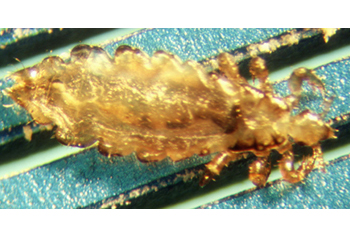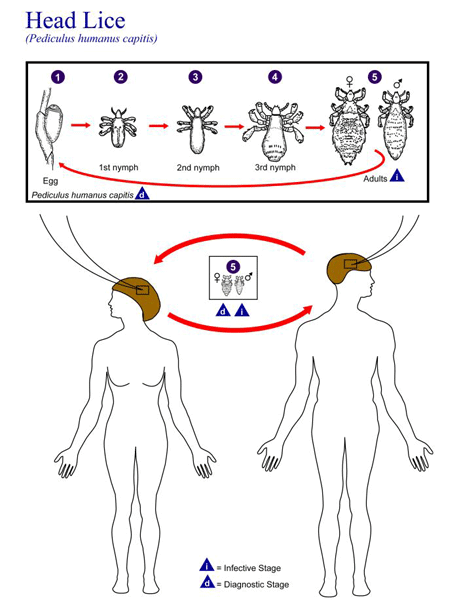Adult head lice are generally 2 to 3 mm long (i.e., the size of a sesame seed) and are usually pale gray, although color may vary. The female can live up to 3 to 4 weeks, and lays approximately 10 eggs a day. These eggs are firmly attached to the hair shaft approximately 3 to 4 mm from the scalp with a glue-like substance. Viable eggs develop an "eye spot" seen on microscopic examination within several days of being laid. Eggs are most easily seen along the hairline at the nape of the neck and behind the ears.[2]Burgess I. Human lice and their control. Ann Rev Entomol. 2004 Jan;49:457-81.
http://www.ncbi.nlm.nih.gov/pubmed/14651472?tool=bestpractice.com
[3]Ko CJ, Elston DM. Pediculosis. J Am Acad Dermatol. 2004 Jan;50(1):1-12.
http://www.ncbi.nlm.nih.gov/pubmed/14699358?tool=bestpractice.com
[4]Leung AK, Fong JH, Pinto-Rojas A. Pediculosis capitis. J Ped Health Care. 2005 Nov-Dec;19(6):369-73.
http://www.ncbi.nlm.nih.gov/pubmed/16286223?tool=bestpractice.com
[14]Meinking TL. Infestations: pediculosis. Curr Probl Dermatol. 1996;24:157-63.
http://www.ncbi.nlm.nih.gov/pubmed/8743266?tool=bestpractice.com
[15]Gratz NG; World Health Organization/WHOPES. Human lice: their prevalence, control and resistance to insecticides - a review, 1985-1997. August 1997 [internet publication].
https://apps.who.int/iris/bitstream/handle/10665/63791/WHO_CTD_WHOPES_97.8.pdf
The eggs are incubated by body heat and hatch in 7 to 14 days. Empty egg casings (often referred to as nits, although many use the same term to refer to both live and hatched eggs) are white and easier to see, but will be located farther from the scalp as the hair grows. Hatched nymphs grow for about 9 to 12 days, mate and then females lay eggs. If not treated, the cycle can repeat itself about every 3 weeks. Lice rarely survive more than 24 hours off a host head.[2]Burgess I. Human lice and their control. Ann Rev Entomol. 2004 Jan;49:457-81.
http://www.ncbi.nlm.nih.gov/pubmed/14651472?tool=bestpractice.com
[3]Ko CJ, Elston DM. Pediculosis. J Am Acad Dermatol. 2004 Jan;50(1):1-12.
http://www.ncbi.nlm.nih.gov/pubmed/14699358?tool=bestpractice.com
[4]Leung AK, Fong JH, Pinto-Rojas A. Pediculosis capitis. J Ped Health Care. 2005 Nov-Dec;19(6):369-73.
http://www.ncbi.nlm.nih.gov/pubmed/16286223?tool=bestpractice.com
[14]Meinking TL. Infestations: pediculosis. Curr Probl Dermatol. 1996;24:157-63.
http://www.ncbi.nlm.nih.gov/pubmed/8743266?tool=bestpractice.com
[15]Gratz NG; World Health Organization/WHOPES. Human lice: their prevalence, control and resistance to insecticides - a review, 1985-1997. August 1997 [internet publication].
https://apps.who.int/iris/bitstream/handle/10665/63791/WHO_CTD_WHOPES_97.8.pdf
Head lice require frequent blood meals, and feed by injecting small amounts of saliva and taking tiny amounts of blood from the scalp every few hours. This saliva usually causes an allergic reaction presenting as an itchy irritation. Itching may not develop for 4 to 6 weeks or longer in an initial infestation because it takes time to develop sensitivity to lice saliva. With a reinfestation, itching can develop quickly. However, some individuals do not develop an allergic reaction and they remain asymptomatic.[3]Ko CJ, Elston DM. Pediculosis. J Am Acad Dermatol. 2004 Jan;50(1):1-12.
http://www.ncbi.nlm.nih.gov/pubmed/14699358?tool=bestpractice.com
[4]Leung AK, Fong JH, Pinto-Rojas A. Pediculosis capitis. J Ped Health Care. 2005 Nov-Dec;19(6):369-73.
http://www.ncbi.nlm.nih.gov/pubmed/16286223?tool=bestpractice.com
Head lice, like body lice, may act as disease vectors.[16]Houhamdi L, Parola P, Raoult D. Les poux et les maladies transmises à l’homme [in French]. Médecine Tropicale. 2005;65:13-23.[17]Feldmeier H. Lice as vectors of pathogenic microorganisms. In: Heukelbach J, ed. Management and control of head lice infestation. Bremen: UNIMED; 2010:132-5.[18]Boutellis A, Mediannikov O, Bilcha KD, et al. Borrelia recurrentis in head lice, Ethiopia. Emerg Infect Dis. 2013 May;19(5):796-8.
https://www.ncbi.nlm.nih.gov/pmc/articles/PMC3647509
http://www.ncbi.nlm.nih.gov/pubmed/23648147?tool=bestpractice.com
[19]Antinori S, Mediannikov O, Corbellino M, et al. Louse-borne relapsing fever among East African refugees in Europe. Travel Med Infect Dis. 2016 Mar-Apr;14(2):110-4.
http://www.ncbi.nlm.nih.gov/pubmed/26872415?tool=bestpractice.com
Lice only consume a few microliters of blood in their lifetime, and infested individuals in the US rarely harbor more than a dozen live lice. Anemia from blood loss due to head lice infestation has never been documented.[3]Ko CJ, Elston DM. Pediculosis. J Am Acad Dermatol. 2004 Jan;50(1):1-12.
http://www.ncbi.nlm.nih.gov/pubmed/14699358?tool=bestpractice.com
[4]Leung AK, Fong JH, Pinto-Rojas A. Pediculosis capitis. J Ped Health Care. 2005 Nov-Dec;19(6):369-73.
http://www.ncbi.nlm.nih.gov/pubmed/16286223?tool=bestpractice.com
Intense itching can occasionally disrupt sleep, and vigorous scratching that disrupts the integrity of the skin can rarely be associated with scalp impetigo and local adenopathy.[2]Burgess I. Human lice and their control. Ann Rev Entomol. 2004 Jan;49:457-81.
http://www.ncbi.nlm.nih.gov/pubmed/14651472?tool=bestpractice.com
[3]Ko CJ, Elston DM. Pediculosis. J Am Acad Dermatol. 2004 Jan;50(1):1-12.
http://www.ncbi.nlm.nih.gov/pubmed/14699358?tool=bestpractice.com
[4]Leung AK, Fong JH, Pinto-Rojas A. Pediculosis capitis. J Ped Health Care. 2005 Nov-Dec;19(6):369-73.
http://www.ncbi.nlm.nih.gov/pubmed/16286223?tool=bestpractice.com
[14]Meinking TL. Infestations: pediculosis. Curr Probl Dermatol. 1996;24:157-63.
http://www.ncbi.nlm.nih.gov/pubmed/8743266?tool=bestpractice.com
[15]Gratz NG; World Health Organization/WHOPES. Human lice: their prevalence, control and resistance to insecticides - a review, 1985-1997. August 1997 [internet publication].
https://apps.who.int/iris/bitstream/handle/10665/63791/WHO_CTD_WHOPES_97.8.pdf
[Figure caption and citation for the preceding image starts]: Adult louse seen under a microscopeFrom the collection of Dr Richard Pollack; used with permission [Citation ends]. [Figure caption and citation for the preceding image starts]: Unhatched nit of a head lousePublic Health Image Library (PHIL); used with permission [Citation ends].
[Figure caption and citation for the preceding image starts]: Unhatched nit of a head lousePublic Health Image Library (PHIL); used with permission [Citation ends]. [Figure caption and citation for the preceding image starts]: Nymph of head louse about to emerge from eggPublic Health Image Library (PHIL); used with permission [Citation ends].
[Figure caption and citation for the preceding image starts]: Nymph of head louse about to emerge from eggPublic Health Image Library (PHIL); used with permission [Citation ends]. [Figure caption and citation for the preceding image starts]: Illustration of life cycle of head licePublic Health Image Library (PHIL); used with permission [Citation ends].
[Figure caption and citation for the preceding image starts]: Illustration of life cycle of head licePublic Health Image Library (PHIL); used with permission [Citation ends].
 [Figure caption and citation for the preceding image starts]: Unhatched nit of a head lousePublic Health Image Library (PHIL); used with permission [Citation ends].
[Figure caption and citation for the preceding image starts]: Unhatched nit of a head lousePublic Health Image Library (PHIL); used with permission [Citation ends]. [Figure caption and citation for the preceding image starts]: Nymph of head louse about to emerge from eggPublic Health Image Library (PHIL); used with permission [Citation ends].
[Figure caption and citation for the preceding image starts]: Nymph of head louse about to emerge from eggPublic Health Image Library (PHIL); used with permission [Citation ends]. [Figure caption and citation for the preceding image starts]: Illustration of life cycle of head licePublic Health Image Library (PHIL); used with permission [Citation ends].
[Figure caption and citation for the preceding image starts]: Illustration of life cycle of head licePublic Health Image Library (PHIL); used with permission [Citation ends].